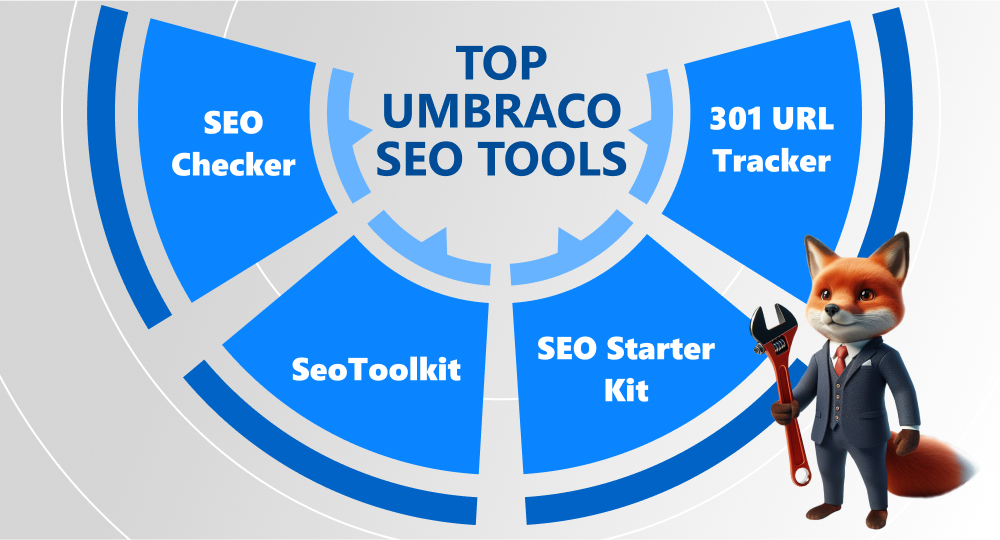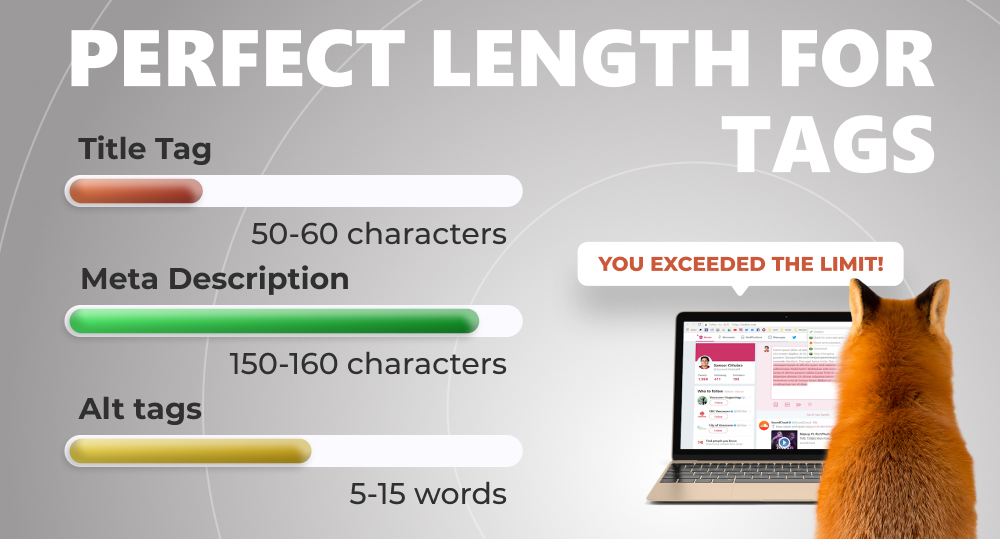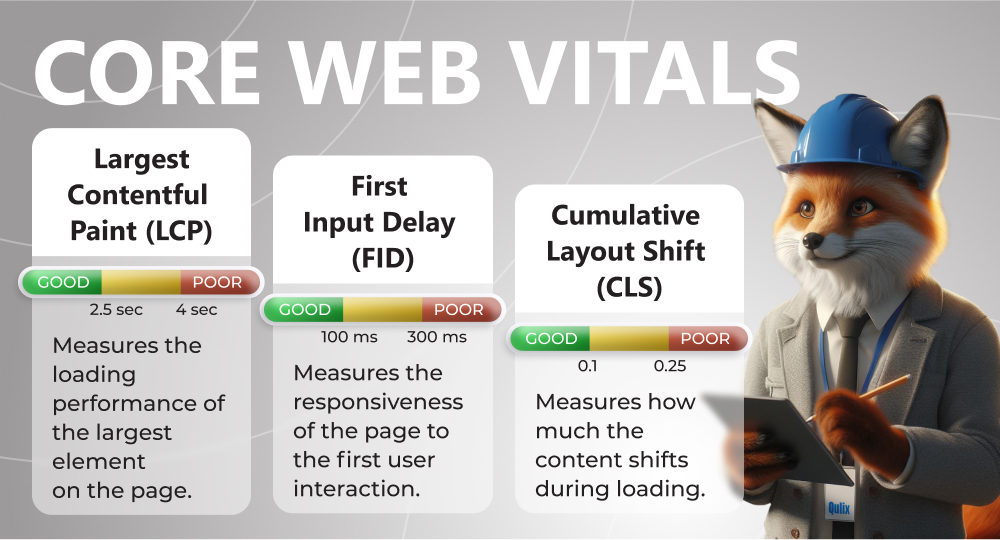Can you dare yourself to skip the Umbraco SEO part? Alas, no. In the 2020s, SEO is integral to the success of any online venture. There have been times when even the biggest brands have stumbled and made mistakes. Take BMW, for example. Back in 2006, the German automobile giant was temporarily banned from Google search results due to the use of “doorway pages”, a black-hat SEO technique. This led to a significant drop in website traffic, proving that no one is immune to SEO traps.
This guide explores how to optimize your Umbraco site for search engines, helping you avoid similar missteps and rank higher in search results.
written by:
Kristina Prokopovich
Project Coordinator
Contents
Umbraco. SEO Friend or Foe?
What's the first result you'll see if you google “Umbraco SEO”? There will be a link to the official website of this CMS, proudly proclaiming: “Umbraco — the SEO-friendly CMS”. But does it live up to its reputation? Let's find out!
Flexibility and Customizability
These two words appear most often on the Umbraco website. There's a reason for that. The CMS empowers users to create custom page structures, optimize URLs, and define metadata for each page. Such a high degree of control allows you to enrich the structure and content of your site with keywords and topics relevant to your target audience.
Built-In Umbraco SEO Tools
Chief on this list is Umbraco SEO Checker. It proofreads every web page according to Google's guidelines, reports SEO issues, and allows you to preview the Google search results snippet and check how any page will look on Facebook and X.
But you don't have to limit yourself to just SEO Checker. Umbraco offers other helpful tools as well:
- SeoToolkit — an Umbraco SEO package for extra help with site optimization (managing meta fields, creating sitemaps, adding custom scripts, etc.);
- SEO Starter Kit — this package works great for building SEO-friendly websites in just a few clicks.
Integration with Third-Party SEO Services
Umbraco is renowned for its cornucopia of integrations. Popular SEO platforms couldn't pass by and ended up on their list. If you already use such tools, Umbraco can help you integrate them into your site. Optimization x2, so to speak!
What's on the list:
- Semrush;
- Google Search Console;
- Siteimprove;
- Textmetrics;
- Huckabuy;
- Silktide.
Performance and Speed Priority
What is the maximum acceptable page load time for users? Ideally, it should not exceed 2 seconds, with a maximum of 4 seconds (Portent). The Umbraco platform is designed with these requirements in mind, as performance and speed are crucial factors in search engine ranking algorithms. Its clean and lightweight codebase, combined with caching capabilities, ensures fast site loading and a smooth user experience.
Umbraco’s Track Record
When evaluating Umbraco’s suitability for SEO, it's essential to examine its performance history.
This CMS has proven to be a solid choice for SEO-conscious organizations. Many Umbraco-powered sites rank high in the SERPs, showcasing the CMS's ability to boost organic traffic and enhance visibility. Here are some notable examples:
Key SEO Strategies and Tactics for Umbraco Projects
Have you ever heard that SEO can be broken down into S for strategy, E for execution, and O for optimization? The word “strategy” comes first, but not just because it starts with an “S”. Without a solid optimization strategy, your site will hardly climb to the top of the Search-Results mountain. Umbraco website performance is no exception. Below are some key tactics specifically tailored to tweak SEO in Umbraco.
On-Site Optimization
Spread Out the Keywords
The first and foremost point is self-evident. Without keywords, your Umbraco project will rest untouched at the very bottom of Google, which even the most curious Internet surfers won't reach. To prevent this from happening, double-check that all the relevant keywords are strategically placed in all on-page elements — meta fields, titles, headings, content, and URLs.
Play with Title Tags and Meta Descriptions
Umbraco offers advanced meta tag management, enabling you to optimize page titles and meta descriptions for targeted keywords. Simply navigate to the specific page you want to revamp and add title tag and meta description properties to your document. You can render them at any time in your master template or in SEO Starter Kit.
Best practices:
- Use Umbraco tag helpers to add and manage meta tags;
- Create a unique and descriptive title for each page, as duplication can confuse search engines;
- Keep title tags and meta descriptions within the recommended character limit (50–60 characters for titles and 150–160 for descriptions);
- Place important keywords at the beginning;
- Mention your brand name;
- Don't make the page title tag similar to H1;
- Don't add too many keywords in the description, as Google may not display it (here's research on this issue).
Scrutinize the Page URL
A well-optimized URL should convey the essence of the page while strategically incorporating relevant keywords that align with the search queries of your target audience. If you have a blog post about “The Secret Pizza Sauce”, a good URL structure should look like this: “www.yourwebsite.com/secret-pizza-sauce/”. Fortunately, Umbraco has a built-in feature that converts page titles into URLs with the same structure. If you wish to modify it, you can make the desired adjustments using a routing property.
Regarding Umbraco SEO URL tools, there is an excellent redirect management feature available. It handles URL changes and prevents the creation of duplicate or broken links.
Best practices:
- Keep URLs concise at every page level;
- Use hyphens and lowercase letters, as they're more readable and SEO-friendly than underscores or spaces;
- Build a logical URL structure;
- Try 301 URL Tracker, an Umbraco SEO plugin used to create redirects to a new URL.
Insert Internal Links
Internal links connect different pages within one website. They not only build up search engine optimization but also encourage visitors to explore more pages of your site, boosting engagement and reducing bounce rates. To insert internal links in Umbraco CMS, you can use the built-in Rich Text Editor. Simply highlight the desired text and add a hyperlink to another page.
Best practices:
- Create a logical site structure with a hierarchy of pages;
- Use descriptive anchor text that provides context for both users and search engines;
- Link to relevant content to help search engines understand the topical relevance of your context;
- Aim for a reasonable number of internal links;
- Update and fix broken links.
Polish Up Your Alt Tags
You may wonder: “Who really cares about alts?” Well, search engines and visually impaired users who rely on screen readers. The best advice here (besides “Don't forget to add them!”) is to make sure your alternative text accurately describes the image. But be mindful of keyword overuse — strike a balance between optimization and readability, so your content node doesn't appear spammy.
Best practices:
- Don't use an alt text for decorative or spacer images;
- Keep your texts brief (5–15 words);
- Use the Umbraco media library to manage and add alt texts to your images;
- Review and update your alts regularly.
Perfect Heading Tags
Remember we discussed the hierarchical structure of a website? That's exactly what headings are made for. Besides, they indicate the importance of different sections of content. What types are there?
- H1 is used for the main title of the page, summarizing its central topic or purpose.
- H2 is used for subheadings directly related to the main heading. It emphasizes significant subtopics or sections on the page.
- H3 to H6 are less critical, but they still add to the overall readability and usability of the page.
Best practices:
- Follow a logical hierarchy: add H1 first, then H2, and H3–H6 after them;
- Use the Umbraco rich text editor to place headings;
- Make sure your headings represent a summary of the section topic;
- Remember to add SEO keywords.
Technical SEO Features
Work on Mobile-Friendliness
Umbraco ensures your website has a fully responsive design that delivers an excellent user experience across all kinds of devices, from tiny smartphones to large TV sets. This is a significant perk when considering Google's focus on mobile-first indexing.
Best practices:
- Use an Umbraco grid layout to design adaptive web pages with an easy-to-navigate interface;
- Improve the page loading speed with Umbraco CDN, which minifies JS, CSS, and HTML code, compresses images, and caches content.
Add Canonical Tags
These are HTML elements indicating the preferred version of a page to search engines. They're especially useful when you have multiple domains that host identical content. Bear in mind that you should only use a canonical URL for legitimate reasons: when you have printer-friendly versions of the same page or paginated content.
Best practice:
- To create a canonical URL based on existing fields, you can either use a simple text field for manual entry or a content picker that allows you to select a page from a content tree structure.
Craft XML Sitemaps
An XML sitemap is a guide for web crawlers to analyze and index your website. Umbraco enables you to customize your sitemap by including or excluding specific pages, setting priority levels for different links, and determining update frequency. With this full control, search engines prioritize and crawl your most important pages more often.
Best practices:
- To create XML sitemaps as well as a sitemap index with all your sitemaps listed within, use a special SEO plugin for Umbraco — SEO Tool Kit;
- Navigate to XML-Sitemaps.com to test the validity of your creation.
Arrange Noindex & Nofollow Settings
To control the crawlability of your website and avoid duplicate or low-quality pages, you can use two meta tags: noindex and nofollow.
- Add the rel=“nofollow” attribute to your source code to flag any links that you don't want search engines to follow. This will help you prevent passing link juice to untrustworthy resources or avoid connecting with sources unrelated to your content.
- By setting the “noindex” attribute, you can keep web pages from appearing in search engine results, ensuring only original content is indexed and displayed to users.
Note: use these settings strategically and sparingly, as applying them to the wrong pages can negatively impact your website visibility and organic traffic.
Handle 404 Broken Links
When a user hits a link that leads to a web page that no longer exists, they'll see a 404 error message. This can frustrate your visitors and negatively affect your website optimization. Umbraco offers two options to solve this problem:
- Return a 404 status code to tell search engine crawlers that the content doesn't exist;
- Create a custom page with a separate document type and design that matches the overall look of your site.
PRO tip: spruce up your 404 page with a link to your home page and other valuable pages to help users navigate your website and not leave you for rivals.
Secure with HTTPS
Just like cybercriminals hate web security, search engines adore it. This is the primary reason why they favor and give a slight ranking boost to websites with HTTPS enabled.
HTTPS is a secure version of the HTTP protocol, which ensures that the data transmitted between a site and its users is encrypted and safe. By adopting HTTPS support on your Umbraco website, not only you protect your users' personal information but also signal to search engines that your service is trustworthy.
Note: Umbraco Cloud has zero-config HTTPS enabled by default and at no extra cost.
Work on Your robots.txt File
The robots.txt file is a small text file that resides in the root directory of your website. It informs search engine crawlers which pages or files they should or should not crawl. By properly configuring this file, you can achieve better performance of your website in SERPs. By default, Umbraco doesn't contain a robots.txt file. You can manually add and edit it through the backend interface.
Tracking and Measuring SEO Performance
Alright, Umbraco SEO tools are all set up, metadata and new scripts for broken links are fine-tuned. What's next? The final step is ongoing analytics and monitoring. Here are the best practices our SEO team recommends employing:
Get Assistance from Google Tools
Since the world considers Google as the #1 search engine, it reciprocates this positive attitude. To optimize your website and track its progress, Google offers an abundance of tools that you can seamlessly integrate into Umbraco:
- Google Tag Manager: for simple tag implementation and management;
- Google Search Console: for monitoring, maintaining, and troubleshooting your site's presence in search results;
- Google Analytics: for measuring and analyzing traffic, conversions, and user behavior.
Check the Core Web Vitals Parameters
This is a set of metrics that evaluate the loading, interactivity, and visual stability of web pages. Core Web Vitals parameters are also part of Google's ranking algorithm and can affect your SEO performance. Umbraco lets users track and optimize these metrics via Google PageSpeed Insights and Google Lighthouse.
Umbraco vs. WordPress: SEO Battle
One last thing. We can't ignore the eternal rivalry between Umbraco and WordPress. If you're still hesitant that Umbraco might not be right for you, we recommend studying the comparison table below. Better yet, consult with an expert Umbraco team to assess your needs and determine which CMS will best serve your optimization strategy.
Category
Umbraco
WordPress
The major perk
Flexibility and scalability, with more control over the structure and content of your site.
A broad range of plugins and tools to simplify website optimization.
Speed & performance
Delivers fast-loading sites.
Mostly delivers fast-loading sites, but its larger user base and extensive plugin library can sometimes lead to slower page load times.
Required level of tech expertise
Medium
Low
Built-in SEO tools
Yes
Yes
Price of add-ons
Free and paid
Free and paid
Is it suitable for enterprise and complex websites?
Yes. Umbraco can handle high traffic and large amounts of data without sacrificing site speed and quality.
50/50. Large websites may require certain actions to properly optimize.
An ideal user
Anyone who prefers a more customizable and scalable platform and has the technical skills and knowledge to implement SEO features and strategies.
Anyone who prefers a more user-friendly CMS with a wide range of plugins and themes, and who doesn't mind a limited library of pre-built templates.
Conclusion: Make or Break Your SEO Efforts
While Umbraco is often considered an “SEO-friendly CMS”, you should note that effective search engine optimization requires more than just a robust content management tool. Ongoing effort, strategic content creation, and off-page SEO measures are what walks your website to the first page of Google search results and attracts targeted organic traffic. Content management systems like Umbraco only lay the groundwork for optimizing your web software. However, it's up to you to implement best practices and keep monitoring and refining your SEO strategy.
Not sure if you can tackle Umbraco alone? Then you simply need an SEO-battle-tested team! Reach out to us, and we'll help you join forces with SEO experts who know their thing.
FAQ
Sure! This platform is designed with SEO in mind and heart. Umbraco empowers you to customize URLs, meta tags, headings, and other essential SEO elements. It also has built-in features for generating sitemaps and managing redirects.
It offers a thorough analysis of key SEO elements on a website:
- Meta tags;
- Headings;
- Alt tags;
- URLs.
It also checks for broken links, duplicate content, and missing alt tags, providing suggestions for improvement.
You don't have to. By utilizing Qulix SEO services coupled with Umbraco CMS, you can enhance your website's search engine performance, increase natural traffic, and reach a wider online audience. What we'll do for you:
- Analyze your website;
- Conduct comprehensive keyword research;
- Optimize on-page elements;
- Improve site speed and mobile responsiveness;
- Build high-quality backlinks;
- Provide ongoing monitoring and reporting to ensure higher positions for your site in SERPs.
Umbraco offers a few plugins, or packages, great for SEO purposes:
- SEO Checker;
- SeoToolkit;
- 301 URL Tracker;
- SEO Starter Kit.

Contacts
Feel free to get in touch with us! Use this contact form for an ASAP response.
Call us at +44 151 528 8015
E-mail us at request@qulix.com











